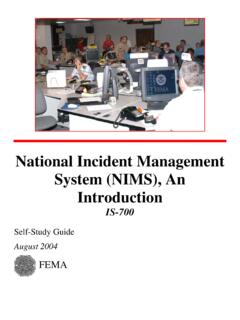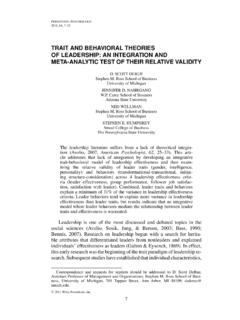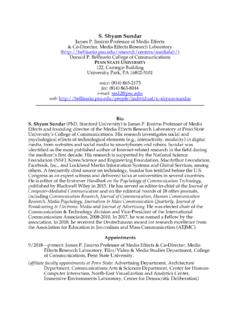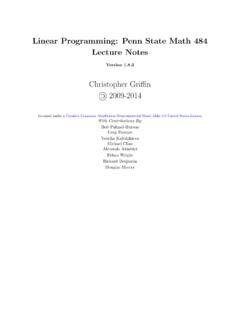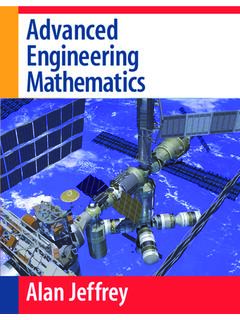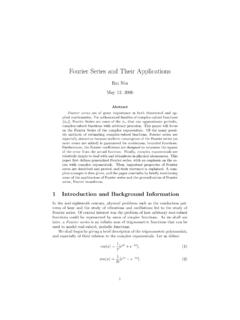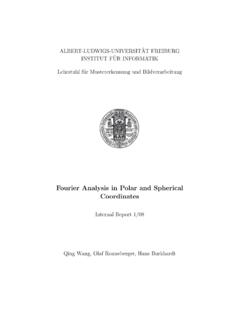Transcription of 11.3 FOURIER COSINE AND SINE SERIES
1 The result of Problem 7 to show the result of Problem 9 to show that21. (a)Use the complex exponential form of the cosineand sine , sinn px ein x/p e in x/p2i, cosn px ein x/p e in x/p2 4 12 11 3 13 5 15 7 17 9 . 4 1 13 15 17 .408 CHAPTER 11 orthogonal functions AND FOURIER SERIESto show that (8) can be written in the complex formwherewheren 1, 2, 3, ..(b)Show that c0,cn, and c nof part (a) can be writtenas one the results of Problem 21 to find the complex form ofthe FOURIER SERIES of f(x) e xon the interval [ p,p].cn 12p p pf(x)e in x/pdx, n 0, 1, 2.
2 C0 a02, cn (an ibn)2, and c n (an ibn)2,f(x) n cnein x/p, FOURIER COSINE AND sine SERIESREVIEW MATERIAL Sections and effort that is expended in evaluation of the definite integrals that definethe coefficients the a0,an, and bnin the expansion of a function fin a FOURIER SERIES is reducedsignificantly when fis either an even or an odd function. Recall that a function fis said to beOn a symmetric interval such as ( p,p) the graph of an even function possesses symmetry withrespect to the y-axis, whereas the graph of an odd function possesses symmetry with respect to if f( x) f(x) and odd if f( x) f(x).
3 AND ODD FUNCTIONSIt is likely that the origin of the terms evenandoddderives from the fact that the graphs of polynomial functions that consist of alleven powers of xare symmetric with respect to the y-axis, whereas graphs of polyno-mials that consist of all odd powers of xare symmetric with respect to origin. Forexample,See Figures and The trigonometric COSINE and sine functions are evenand odd functions , respectively, since cos( x) cosxand sin( x) functions f(x) exandf(x) e xare neither odd nor following theorem lists some properties of even and (x) x2 is evensince f( x) ( x)2 x2 f(x)even integerf(x) x3 is oddsince f( x) ( x)3 x3 f(x).
4 Odd integerx xyxy =x2f( x)f(x)FIGURE function; graphsymmetric with respect to y-axisFIGURE function; graphsymmetric with respect to origin xxy=x3f( x)f(x)xyTHEOREM of Even/Odd functions (a)The product of two even functions is even.(b)The product of two odd functions is even.(c)The product of an even function and an odd function is odd.(d)The sum (difference) of two even functions is even.(e)The sum (difference) of two odd functions is odd.(f)Iffis even, then (g)Iffis odd, then PROOF OF (b)Let us suppose that fandgare odd functions .
5 Then wehavef( x) f(x) and g( x) g(x). If we define the product of fandgasF(x) f(x)g(x), thenThis shows that the product Fof two odd functions is an even function. The proofs ofthe remaining properties are left as exercises. See Problem 48 in Exercises AND sine SERIESI ffis an even function on ( p,p), then in view of theforegoing properties the coefficients (9), (10), and (11) of Section becomeSimilarly, when fis odd on the interval ( p,p),We summarize the results in the following COSINE and sine SERIES (i) The FOURIER SERIES of an even function on the interval ( p,p) is thecosine SERIES (1)where(2)(3)an 2p p0f(x) cos 2p p0f(x)dxf(x) a02 n 1an cosnppx,an 0, n 0, 1, 2.
6 , bn 2p p0f(x) sinn pxdx. f(x) cosx dx f(x) cosx dx even1 p2 p2 p f(x)dx a0 f(x)dx p pp01 pnp pnp pan p pp0 f(x) sinx dx 0odd1 pnp pbn p pF( x) f( x)g( x) ( f(x)) ( g(x)) f(x)g(x) F(x). a af(x)dx 0. a af(x)dx 2 a0f(x) COSINE AND sine SERIES 409(ii) The FOURIER SERIES of an odd function on the interval ( p,p) is the sineseries(4)where(5)EXAMPLE 1 Expansion in a sine SeriesExpandf(x) x, 2 x 2 in a FOURIER of Figure shows that the given function is odd on theinterval ( 2, 2), and so we expand fin a sine SERIES . With the identification 2p 4we have p 2.
7 Thus (5), after integration by parts, isTherefore(6)The function in Example 1 satisfies the conditions of Theorem Hencethe SERIES (6) converges to the function on ( 2, 2) and the periodic extension (of period 4) given in Figure (x) 4 n 1( 1)n 1n sinn 20x sinn 2xdx 4( 1)n 1n .bn 2p p0f(x) sin nppxdx. f(x) n 1bn sin nppx,410 CHAPTER 11 orthogonal functions AND FOURIER SERIES 11xy FIGURE function inExample 2xyy=x, 2 < x< 2 FIGURE function inExample 1 FIGURE extension of function shown in Figure 10 8 6 4 2246810 EXAMPLE 2 Expansion in a sine SeriesThe function shown in Figure is odd on the interval ( p,p).
8 With p pwe have, from (5),and so(7)GIBBS PHENOMENONWith the aid of a CAS we have plotted the graphs S1(x),S2(x),S3(x), and S15(x) of the partial sums of nonzero terms of (7) in Figure Asseen in Figure (d), the graph of S15(x) has pronounced spikes near the discontinu-ities at x 0,x p,x p, and so on. This overshooting by the partial sums SNfrom the functional values near a point of discontinuity does not smooth out but remainsfairly constant, even when the value Nis taken to be large. This behavior of a Fourierseries near a point at which fis discontinuous is known as the Gibbs (x) 2 n 11 ( 1)nn sin 2 0(1) sin nx dx 2 1 ( 1)nn,f(x) 1, x 0 1, 0 x ,The periodic extension of fin Example 2 onto the entire x-axis is a meanderfunction (see page 290).
9 COSINE AND sine SERIES 411 FIGURE sums of sine SERIES (7)(a)S1(x)(b)S2(x)(c)S3(x)(d)S15(x)yx-3 -2 -1-3 -2 -1-3 -2 -1-3 -2 EXPANSIONST hroughout the preceding discussion it wasunderstood that a function fwas defined on an interval with the origin as itsmidpoint that is, ( p,p). However, in many instances we are interested in repre-senting a function that is defined only for 0 x Lby a trigonometric SERIES . Thiscan be done in many different ways by supplying an arbitrary definitionoff(x) for L x 0. For brevity we consider the three most important cases.
10 If y f(x) isdefined on the interval (0,L), then(i)reflect the graph of fabout the y-axis onto ( L, 0); the function is noweven on ( L,L) (see Figure ); or(ii)reflect the graph of fthrough the origin onto ( L, 0); the function is nowodd on ( L,L) (see Figure ); or(iii) define fon ( L, 0) by y f(x L) (see Figure ).Note that the coefficients of the SERIES (1) and (4) utilize only the definition ofthe function on (0,p) (that is, half of the interval ( p,p)). Hence in practice thereis no actual need to make the reflections described in (i) and (ii).
